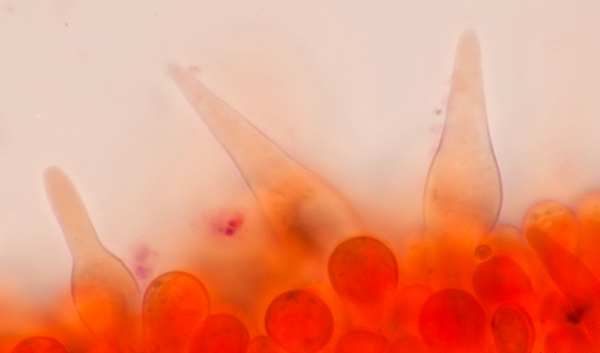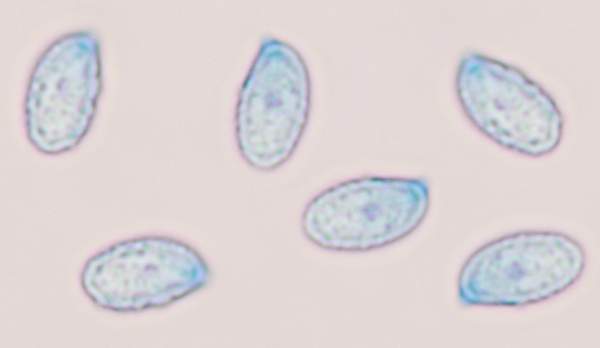Melanoleuca cognata (Fr.) Konrad & Maubl. - Spring Cavalier
Phylum: Basidiomycota - Class: Agaricomycetes - Order: Agaricales - Family: Tricholomataceae
Distribution - Taxonomic History - Etymology - Identification - Culinary Notes - Reference Sources
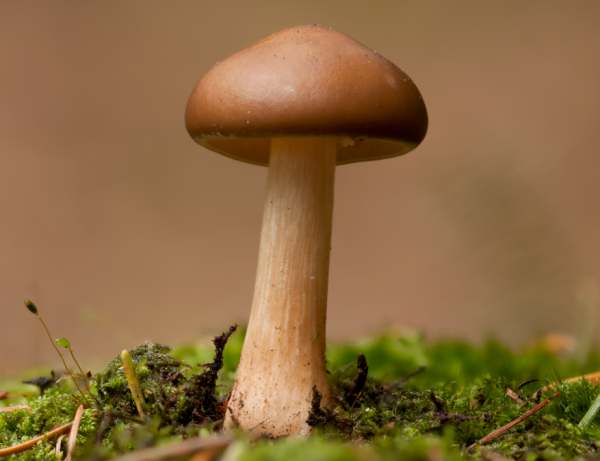
With a large brownish cap covering pallid gills, this is a tricky species to identify from macroscopic features alone... unless you find it early in the year befiore other large fungi begin fruiting. Apart from the Spring Cavalier Melanoleuca cognata and St George's Mushroom Calocybe gambosa, very few large agarics appear in springtime. (Be aware, though, that both of these early fruiting mushrooms can also be found later in the year, when separating them from other summer and autumn mushroom species is more difficult.)
Distribution
An occasional find throughout Britain and Ireland, Melanoleuca cognata is recorded most often in the south of England and seems to be less common further north; this lovely mushroom is also found throughout Northern and Central Europe and is reported to be fairly common also in North America.
Taxonomic history
The Spring Cavalier was described in 1838 by Swedish mycologist Elias Magnus Fries, who gave it the name Agaricus arcuatus var. cognatus. Its currently accepted scientific name Melanoleuca cognata dates from a 1926 publication by French mycologists Paul Konrad (1877 - 1948) and André Maublanc (1880 - 1958).
Synonyms of Melanoleuca cognata include Agaricus arcuatus var. cognatus Fr., Tricholoma cognatum (Fr.) Gillet, and Tricholoma arcuatum f. robusta J. E. Lange.
Etymology
The genus name Melanoleuca comes from the Ancient Greek words melas meaning black, and leucos meaning white. No cavalier mushroom is truly black and white, but many have caps whose upper surfaces are various shades of brown, with whitish gills beneath.
The specific epithet cognata literally means 'born with', often interpreted as 'kindred' meaning closely related..
Identification guide
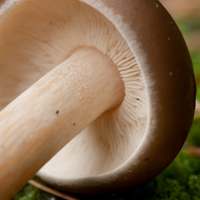 |
CapVarying between specimens from ochre-brown to grey-brown, the cap is initially hemispherical becoming convex and then flattening with a low umbo and retaining a downturned often wavy margin; 4 to 12cm across when fully expanded. The cap surface is smooth sometimes sticky; its flesh is pale cream. GillsSinuate (with a decurrent tooth), crowded; pinkish cream to ochre-cream. Stem6-12 com long and 1-1.5cm in diameter, slightly swollen towards the base; cream, often with an ochre-brown flush; no stem ring. |
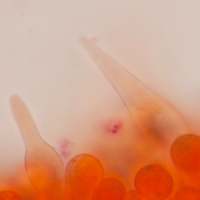 |
CheilocystidiaThin-walled, hyaline, lanceolate; some cystidia are encrusted with crystals at the apex. |
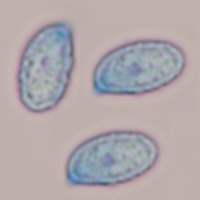 |
SporesEllipsoidal, finely warty, 7-9.5 x 4-6μm; amyloid. Spore printPale cream. |
Odour/taste |
Odour farinaceous (floury); taste mild, sweet. |
Habitat & Ecological role |
Saprobic, on soil and needle litter in coniferous woodlands; occasionally in litter-rich grassland, woodchip or garden compost heaps. |
Season |
The Spring Cavalier might better be called the Spring-and-Autumn Cavalier, because in Britain and Ireland it fruits not only in April and May but also again from August until the first hard frosts destroy most fleshy fungi - often in November out in the west of Wales.. |
Similar species |
Melanoleuca melaleuca is macroscopically very similar, but it can be separated by microscopic examination of the spores, cystidia etc. More than thirty species in the Melanoleuca genus are recorded from Britain and Ireland, and most have brownish caps and whitish gills; separating them is a task for specialists. (Many of them are very rare finds.) |
Culinary Notes
Some of the so-called 'cavalier' fungi, including the Spring Cavalier Melanoleuca cognata, are reported to be edible but nothing special; however, as these kinds of mushrooms are notoriously difficult to identify I recommend that they should all be considered suspect and not collected for food.
Reference Sources
Fascinated by Fungi, 2nd Edition, Pat O'Reilly 2016, reprinted by Coch-y-bonddu Books in 2022.
Dictionary of the Fungi; Paul M. Kirk, Paul F. Cannon, David W. Minter and J. A. Stalpers; CABI, 2008
Taxonomic history and synonym information on these pages is drawn from many sources but in particular from the British Mycological Society's GB Checklist of Fungi.
Acknowledgements
This page includes pictures kindly contributed by David Kelly.
Fascinated by Fungi. Back by popular demand, Pat O'Reilly's best-selling 450-page hardback book is available now. The latest second edition was republished with a sparkling new cover design in September 2022 by Coch-y-Bonddu Books. Full details and copies are available from the publisher's online bookshop...
